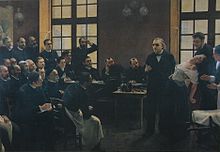Hôpital de la Salpêtrière
The Hôpital de la Salpêtrière in Paris was probably the best-known psychiatric institution in Europe in the 19th century. It is still a hospital today under the name Hôpital Universitaire Pitié Salpêtrière .
history

The Hôpital de la Salpêtrière was built as a hospital at the instigation of Louis XIV (1638–1715) together with the Hôtel des Invalides . Louis Le Vau was responsible for the building project, and Libéral Bruant († 1697) was entrusted with the design of the chapel. The name comes from an earlier, under Louis XIII. founded factory on the site in which ammunition powder containing saltpeter was produced. The Salpêtrière was a gigantic Moloch in the middle of Paris with up to 8,000 patients. Established in 1656 as a hospital especially for women and the mentally ill, it formed the central element of the Hôpital général (association of state hospitals) and was also considered the “largest asylum in Europe”. The Hôpital général was supposed to take in all the poor and beggars and keep them out of the city. Most of them were blocked due to judicial orders.
There was a strict hierarchy among the patients. At the bottom, in “Les Loges des Folles”, old people, beggars, sexually ill, prostitutes, failed suicides, epileptics, dementia and the chronically ill vegetated in the dark, right at the top “the stars paraded”.
In 1795, the psychiatric reformer Philippe Pinel took over the management of the clinic "and took the chains off the sick there," which is not to be taken literally. His student Jean Étienne Esquirol supported him there from 1810 to 1826.
For the publicly exhibited patients - who were sometimes perfect actresses in their role as hysterics - and the doctors treating them, an amphitheater was specially built on the grounds of the Salpêtrière.
The Salpêtrière was the center of a gynecologically defined hysteria at the end of the 19th century . The neurologist Jean-Martin Charcot (1825-1893) also taught there. In 1885 he met Sigmund Freud here and taught him about hypnosis and hysteria.
In 1964 the Hôpital de la Salpêtrière was merged with the Hôpital Pitié to form the "Hôpital de la Pitié-Salpêtrière". This now belongs to the Pierre and Marie Curie University (UPMC), part of the Sorbonne .
The hospital grounds are home to the Institut du cerveau et de la moelle épinière .
Well-known doctors
- Théophile Alajouanine
- Joseph Babinski
- Paul Brouardel
- Jean-Martin Charcot
- Klaus Conrad
- Jules Cotard
- Jean-Etienne Esquirol
- Sigmund Freud
- Carl Gustav Jung
- Pierre Janet
- Ernest-Charles Lasègue
- Jacques Jean Lhermitte
- Pierre Marie
- Philippe Pinel
- Georges Gilles de la Tourette
Trivia
The clinic is anchored in literature in the novel “The Book of Blanche and Marie” by Per Olov Enquist (2004, Stockholm). The heroine of the novel is Blanche Wittman , the "queen of the hysterics". In the novel, after the death of Charcot, she becomes the fictional assistant to the two-time Nobel Prize winner Marie Curie . The character of the fictionality of Blanche Wittman is explicitly emphasized by Enquist and should not give rise to assumptions to suspect a real connection between the real chemist and the fictional character.
The hospital is also the place where the protagonist lives in Sebalds Austerlitz 's shared apartment . after his nervous breakdown as a result of early childhood trauma.
The 1884 hospital is also the main setting for the events in Vera Buck's debut novel Runa .
The main character of Rainer Maria Rilke's only novel The Notes of Malte Laurids Brigge (1910) visits the hospital in the nineteenth record and describes in detail a number of sick people and doctors.
The Salpêtrière served as the location for the filming of the film Cléo de 5 à 7 .
Famous people who died in this hospital include: a .: Josephine Baker and Princess Diana , who was brought here after her car accident. One of the most famous inmates was Jeanne de Saint-Rémy .
In 2007 Amy May, aka Paris Motel, released the album "In The Salpêtrière", which uses the name of the mental hospital as a metaphor.
In the video game " Assassin's Creed Unity ", published in November 2014, the Hôpital de la Salpêtrière is one of the numerous locations.
Web links
Individual evidence
- ↑ a b Eric Hazan: The Invention of Paris: No Step Is In Vain. Zurich 2006, ISBN 3-250-10485-X , pp. 237-238.
- ↑ Magdalena Frühinsfeld: Brief outline of psychiatry. In: Anton Müller. First insane doctor at the Juliusspital in Würzburg: life and work. A short outline of the history of psychiatry up to Anton Müller. Medical dissertation Würzburg 1991, p. 9–80 ( Brief outline of the history of psychiatry ) and 81–96 ( History of psychiatry in Würzburg to Anton Müller ), p. 69 f.
- ↑ Magdalena Frühinsfeld: Brief outline of psychiatry. 1991, pp. 67-78.
- ↑ Université Pierre et Marie Curie. Retrieved August 23, 2014 .
Coordinates: 48 ° 50 ′ 16 ″ N , 2 ° 21 ′ 51 ″ E


